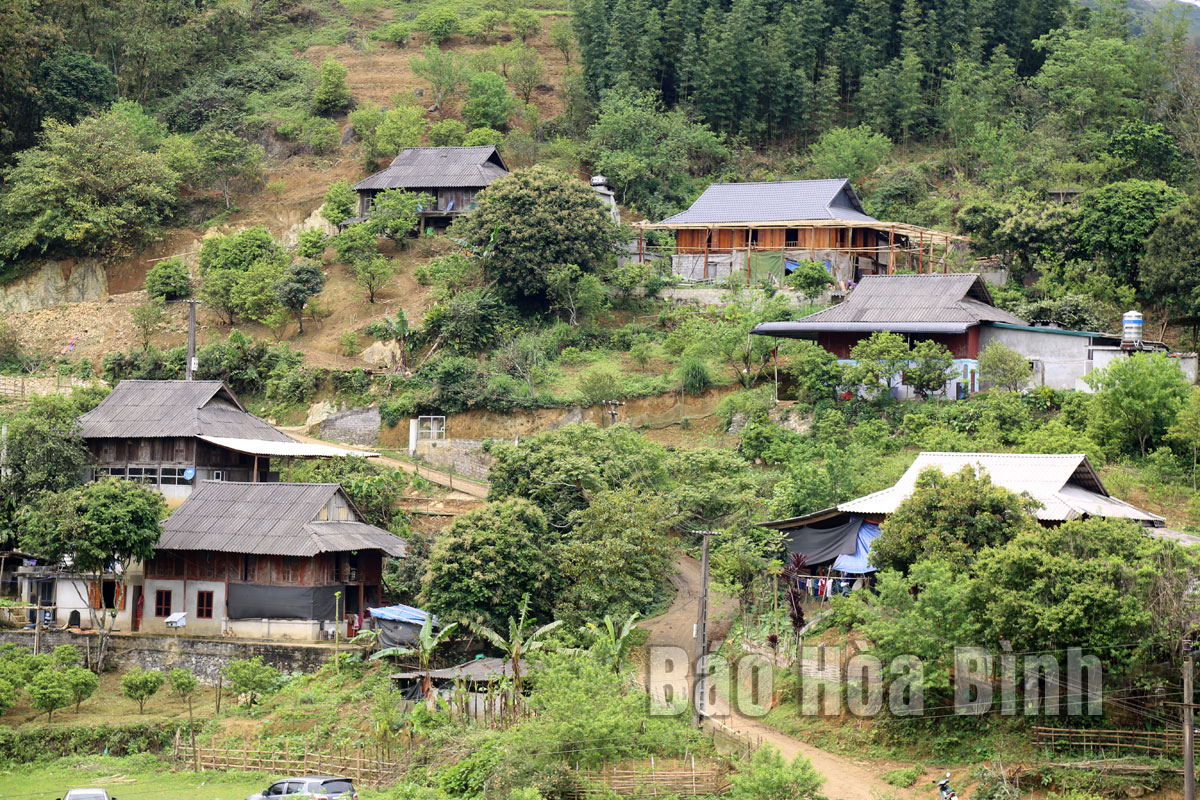
(HBO) - The life of people in Van Son commune (Tan Lac district) are changing day by day thanks to all-out efforts of the local authority and greater investment in infrastructure, agricultural development and community-based tourism.

A
community-based tourism village in Chien hamlet in Van Son commune (Tan Lac
district). The natural beauty and unique traditional cultural identities of the
locality have attracted many tourists.
The community tourism village in Chien hamlet is located about 4 km away from
the centre of Van Son commune at an altitude of around 800m above sea level. The village covers an area of 487 hectares, consisting of 74 households with
347 residents, who mainly make living by agricultural production such as rice
cultivation and raising livestock and poultry. Ancient pomelo gardens in Van Son commune are the highlight in the locality.
In addition to the traditional stilt houses of the Muong ethnic people which
have been preserved almost intact, the tradition of wearing traditional
costumes of people in Chien hamlet have been also restored.
Thanks to its unique cultural identity and potential in terms of geography and
human resources, since 2019, the locality was funded by the Australian
Foundation for the Peoples of Asia and the Pacific Limited(AFAP) to
implement a project on improving sustainable livelihoods through
community-based tourism development. The project benefits three households in the commune, helping them develop
homestay models to provide accommodation services for tourists.
Ha Van Than, owner of Hai Than Homestay, said his family welcomes about 100
visitors per month. Sixty out of 74 households in Chien hamlet have joined community-based tourism
activities in the locality.
The community-based tourism model in Chien hamlet has proven effective, attracting
numerous foreign and domestic tourists. Visitors to the hamlet love to join the
traditional dance and music performance programmes of the Muong ethnic people,
enjoy local foods, and visit beautiful landscapes in the locality.
Van Son used to be called Muong Cham. Later, people also called it poetic names
such as Thung May or Lung May. This is also one of the oldest and largest
cultural cradles of the Muong ethnic group in Hoa Binh. Van Son commune is also home to many natural landscapes, including Nam Son and
Nui Kien caves.
Nam Son cave is located in the buffer areas of Cuc Phuong National Park and
Ngoc Son - Ngo Luong Nature Reserve. It was recognised as a national landscape
relic in 2008. Meanwhile, Nui Kien cave was recognised as a provincial scenic
spot in 2019.
According to Vice Chairman of the People’s Committee of Van Son commune Ha Van
Ha, Van Son has a natural area of 5,553 ha. Agricultural and forestry production is the strength of the commune. Many
households have gradually changed their land for growing crops to growing
tangerines. The total area of tangerine cultivation in the locality increased more than
three times to 181.5 ha from only over 50ha in 2015, contributing to improving
incomes for local residents.
In terms of cultivation, the total cultivated area reached over 1,400 ha,
including 290ha of rice, and over 900 ha of maize. Total output of grain crops
reaches over 5,900 tonnes. Other crops are chayote (21.5 ha), sweet mandarin
(183.3 ha) and peach (43 ha).
In addition to farming, local residents have also focused on developing the
animal husbandryindustry. They maintained 452 heads of buffaloes, 1,983
cow heads, 1,650 pigs, 200 goats and 52,300 heads of poultry.
Policies towards ethnic minorities are well implemented through projects and
national target programme, contributing to gradually improving and raising the
living standards of local people. In 2022, the commune's average per capita
income reached 28.5 million VND. The rate of poor households stood at 29.72%./.
More than just an information technology teacher, Bui Van Nien is an inspiring figure who has nurtured the scientific curiosity and creative spirit of students in Vietnam’s ethnic minority communities.
Da Bac is the most disadvantaged mountainous district in Hoa Binh province, with ethnic minorities accounting for about 90% of its population. Over the past years, the district has mobilised resources to implement ethnic policies to improve the quality of life of local people.
In recent years, Hoa Binh province has consistently prioritised the protection, care, and education of children, particularly those from ethnic minorities and disadvantaged backgrounds, by creating a safe, healthy, and nurturing environment for their all-round development.
The Steering Committee for Tobacco Harm Prevention and Control of Hoa Binh province, in coordination with the Tobacco Harm Prevention and Control Fund, held a ceremony on May 28 in response to the World No Tobacco Day (May 31) and the National No Tobacco Week (from May 25 to 31). The event was chaired by Nguyen Van Toan, Standing Vice Chairman of the provincial People’s Committee and head of the Steering Committee.
Since 2021, the Center for Industrial Promotion and Industrial Development Consulting (CIIDC) under the Department of Industry and Trade has been implementing a school lighting model as part of the plan for using energy efficiently and economically in Hoa Binh Province in the pẻiod of 2021 - 2025. This model not only aims to improve the learning conditions and enhance the education quality, but it also promotes the message of energy saving, energy security, environmental protection and contributes to the goals of socio-economic development.
In the 2024 - 2025 school year, the entire Hoa Binh provincial education sector includes 520 educational institutions and schools. Among them are 13 ethnic boarding schools with 153 classes and 4,487 students. Four of these schools have met national standards, reaching 30.7 percent.



